Deng Tong, Golden Finance
On October 22, 2025, the Kadena team announced that due to unfavorable market conditions, it would immediately cease all business operations and active maintenance. The team expressed gratitude to all supporters and regretted being unable to continue promoting this unique decentralized project. Kadena's native token, KDA, plummeted over 60% that day.
What is Kadena? Why did it suddenly announce the cessation of operations? What implications does it have for the industry?
I. Kadena, a Star from the "JPMorgan Chase" Family
Kadena was founded in 2016 and its mainnet launched in October 2019. It was founded by Wall Street veterans Stuart Popejoy, who led the blockchain development team at JPMorgan Chase in New York, and Will Martino, who previously worked at the U.S. Securities and Exchange Commission and is dedicated full-time to the Kadena project. They previously co-developed JPMorgan Kinexys, JPMorgan Chase's private blockchain system, and later founded the Kadena project, aiming to create a blockchain that combines high performance with decentralized security. As a result, Kadena was arguably the star project of the "JPMorgan Chase" group at the time. Kadena utilizes the Chainweb architecture—multiple parallel chains collaboratively processing transactions to achieve high throughput and low congestion. It also introduced its proprietary smart contract language, Pact, which emphasizes the "secure, auditable, and human-readable" design principles of smart contracts. Kadena offers a hybrid blockchain architecture, including public and private chain solutions. Public chains are decentralized blockchain networks suitable for a wide range of public and commercial applications; private chain solutions provide enterprises with a secure and controllable blockchain environment suitable for handling sensitive data and internal business processes. Kadena was designed to serve as a bridge between enterprises and public chains. KDA is the native cryptocurrency of the Kadena blockchain, used to pay transaction fees, incentivize miners, and participate in platform governance. The initial distribution of KDA tokens is: 70% to miners, 20% for platform reserves, 6% to developers, 3% to contributors, and 1% to be burned.
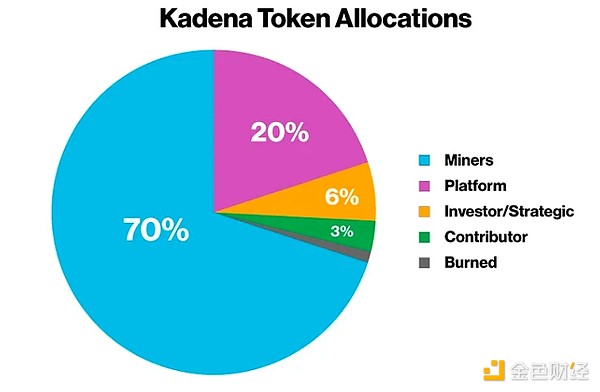
In November 2021, KDA had its heyday, with its price soaring to nearly $25, before falling back to below $5.
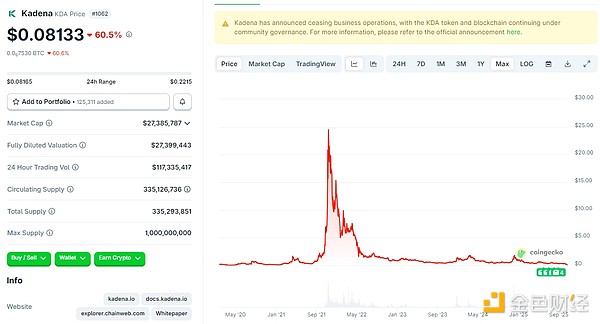
Affected by the news that Kadena announced the cessation of business operations, the price of KDA plummeted, falling by more than 60% in 24 hours, and was reported at $0.06187 as of press time.
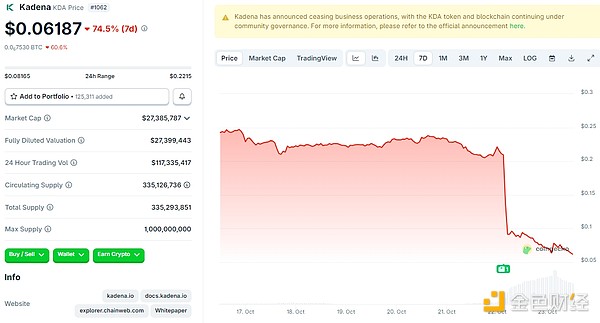
II. Why did Kadena cease operations? Kadena published a tweet on X, outlining the reason for Kadena's discontinuation: market conditions. We are sad to announce that the Kadena organization will no longer be operating and will cease all business activities and maintenance of the Kadena blockchain effective immediately. We sincerely thank everyone who has worked with us on this journey. We deeply regret that market conditions have made it impossible for us to continue promoting and supporting the adoption of this unique decentralized product. We have notified all employees that we will cease operations. We have retained a small team to handle this transition and gradual shutdown. If you have any questions or concerns, please contact [email protected]. The Kadena blockchain is not owned or operated by a company. As a fully decentralized, proof-of-work, smart contract-based blockchain, the network is operated by independent miners, while the on-chain smart contracts and protocols are independently governed by their maintainers. To ensure operational continuity, we will soon provide a new binary to ensure uninterrupted operation without our involvement, and encourage all node operators to upgrade as soon as possible. As for the KDA token and protocol, they will continue to operate even in our absence. As stated in our latest Token Economics Update (https://medium.com/kadena-io/clarification-to-the-2021-token-economics-update-c3502aa50fa1), over 566 million KDA will be distributed as mining rewards until 2139, and 83.7 million KDA issued by the platform will be unlocked in November 2029. We are ready to work with the Kadena community to explore how we can assist with the transition to community governance and maintenance. We will provide timely updates.
We sincerely thank all our team members, community members, and partners who have joined us on this journey. We wish you all the best in the future.
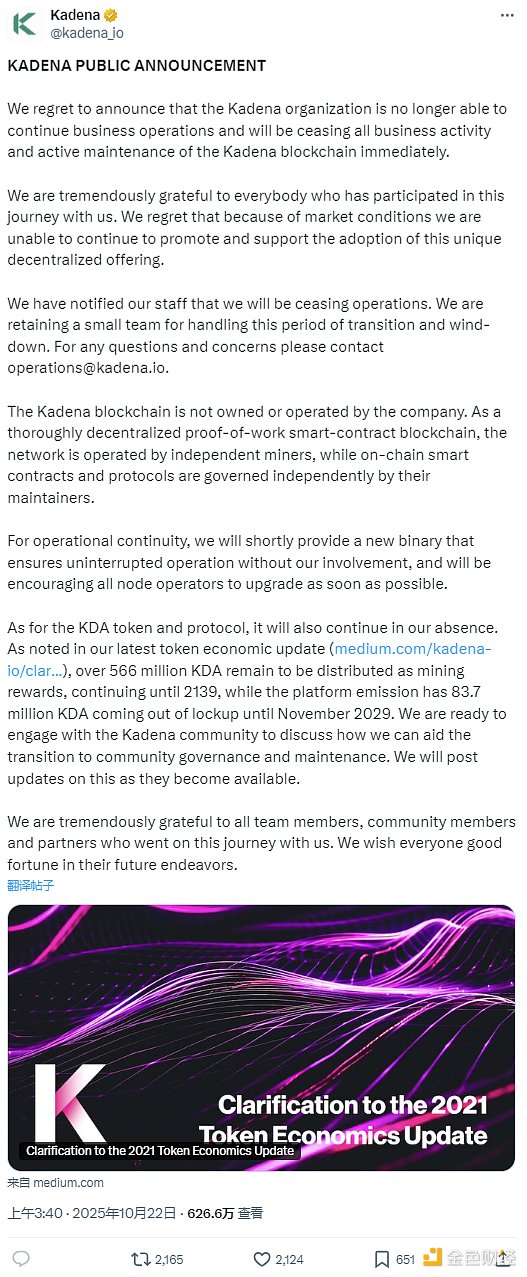
According to Cbin Sights data, the total amount of funds raised for the Kadena project is nearly $15 million. This amount is not a significant amount in the public blockchain space. Besides the long-established Ethereum, projects like Solana, Avalanche, Near, Aptos, and Sui have all raised over $300 million.
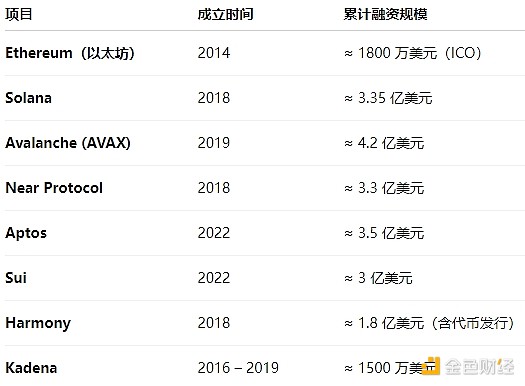
Combined with the aforementioned fact that the KDA price has been below $5 since April 2022, and has even hovered below $1 since April 2013, the extremely sluggish "market conditions" are indeed the main reason why Kadena chose to disappear.
Third, Kadena's Bad Debts
As early as January of this year, Kadena announced a strategic partnership with Ownera: Through this collaboration, Kadena will use its high-performance blockchain technology to support Ownera's IOWN Tokenization Platform, aiming to provide global enterprises with secure and efficient digital asset issuance and management solutions. On July 18th, Binance also announced that it would support the Kadena (KDA) network upgrade and hard fork. Just three months later, Kadena withdrew from the public blockchain scene, leaving behind a legacy of untold accounts. Not only was the 2139 dream far off, but users couldn't even wait for the 83.7 million KDA tokens scheduled for 2029 to be unlocked. According to Kadena's announcement, "Over 566 million KDA will be distributed as mining rewards until 2139, while the 83.7 million KDA tokens issued by the platform will be unlocked in November 2029." The Kadena public chain "failed before it even began," leaving early investors and long-term holders facing the loss of a significant amount of assets. Furthermore, the announcement stated that "the network is operated by independent miners," meaning that miners are the core participants in the Kadena network. Following the announcement of Kadena's closure, miners will also withdraw from mining due to plummeting token prices and a lack of official technical support. This will lead to a decrease in network hashrate, further exacerbating network security risks and transaction delays. Although officials have stated, "To ensure operational continuity, we will soon provide a new binary to ensure uninterrupted operation without our involvement, and encourage all node operators to upgrade as soon as possible," Kadena has yet to come up with a convincing solution. Finally, although Kadena has stated that it will "work with the Kadena community to explore ways to assist with the transition of community governance and maintenance," can the community truly shoulder the responsibility if the network subsequently encounters major technical vulnerabilities? Furthermore, the Kadena ecosystem is already underdeveloped. Without official support, market confidence will be even lower, and new funding, technical participants, and ordinary users will no longer be interested in the project. Ultimately, Kadena will inevitably become a "botnet."
Fourth: Reflections on the Industry
1. Real Applications and Real Users Are King
Even with its impressive JPMorgan Chase background, having launched Kaddex and envisioned scenarios like asset tokenization, bond issuance, real estate, and art on its official website, Kadena lacks real, real applications that can attract a large number of users. Consequently, the ecosystem remains sluggish and the price of its tokens continues to decline. In contrast, public chains like Ethereum and Solana either boast high-quality developer communities and DApps or have created a high-quality user experience with "high performance" and "low cost." Therefore, the public chain sector requires more than just technology and background; it also requires a real user base and tangible, real-world applications to underpin the ecosystem. Without applications and users, there is no dream.
2. Capital Reserves and Operational Implementation Are Both Essential
Kadena has only raised $15 million. Compared to many of the public chains mentioned above, which have raised over $300 million, its risk resilience is not as strong as its competitors. Amid the volatile cryptocurrency market, limited capital reserves cannot guarantee the team's continued operations. Furthermore, compared to other popular public chains, Kadena has rarely been heard of. Given its sluggish operations, its collapse seems inevitable.
3. The Basic Landscape of the Blockchain Industry Has Taken Shape
As the crypto industry matures, the basic structure of each sector has taken shape. Within the public chain sector, giants like Ethereum and Solana have already captured the majority of users and can largely meet industry demand. Other latecomers struggle to build their own user base and achieve profitability.
Conclusion
The demise of the Kadena project isn't entirely regrettable; it reflects the broader trend of the blockchain industry de-bubbling and returning to its roots. During the era of the "public chain wars," countless public chains rose and then quietly fell. Ultimately, however, the industry itself is maturing towards a more rational and pragmatic approach.
 Weatherly
Weatherly









